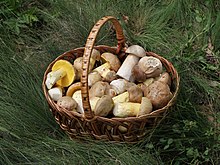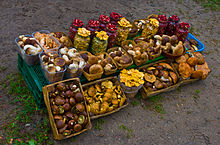
Discina gigas, commonly known as the snow mushroom, snowbank false morel, walnut, giants false morel, snow morel, snow false morel, calf brain, or bull nose, is a species of fungus and a member of the Ascomycota found in Europe. It is referred to as one of the false morels, due to its similar appearance and occurrence in the spring and early summer in similar habitats to true morels.
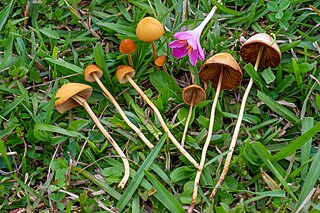
Conocybe tenera, commonly known as the brown dunce cap or common cone head, is a widely distributed member of the genus Conocybe. This mushroom is the type species for the genus Conocybe.
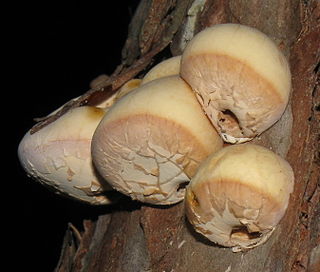
Cryptoporus volvatus, commonly known as the veiled polypore or cryptic globe fungus, is a polypore fungus that decomposes the rotting sapwood of conifers. It is an after effect of attack by the pine bark beetle. The fungus was originally described by American mycologist Charles Horton Peck in 1875 as Polyporus volvatus. Cornelius Lott Shear transferred it to the genus Cryptoporus in 1902. The species is inedible.

Panaeolus semiovatus var. semiovatus, also known as Panaeolus semiovatus and Anellaria separata, and commonly known as the shiny mottlegill, ringed panaeolus, or egghead mottlegill, is a medium-sized buff-colored mushroom that grows on horse dung, and has black spores. Though nonpoisonous, it is generally regarded as inedible, and a few people experience gastric upset after consumption.
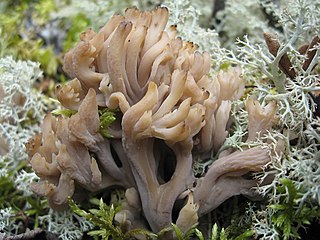
Clavulina cristata, commonly known as the wrinkled coral fungus, white coral fungus or the crested coral fungus, is a white- or light-colored edible coral mushroom present in temperate areas of the Americas and Europe. It is the type species of the genus Clavulina.

Leucoagaricus leucothites, commonly known as the smooth parasol, woman on motorcycle, ma'am on motorcycle, white dapperling, or white agaricus mushroom, is a species of agaric fungus. The species was originally described as Agaricus leucothites by Carlo Vittadini in 1835, and bears similarity to species of that genus. Solomon Wasser transferred it to Leucoagaricus in 1977. While sometimes regarded as edible, the species is suspected of being poisonous due to gastric-upset-causing toxins. It could also be confused with the deadly Amanita ocreata.
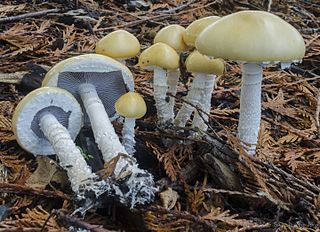
Stropharia ambigua, sometimes known as the questionable Stropharia, is a saprotrophic agaric mushroom, commonly fruiting in leaf litter and wood chips in the Pacific Northwest.

Cortinarius collinitus, commonly known as the belted slimy cortinarius, is a species of fungus in the family Cortinariaceae.

Lepiota castanea, commonly known as the chestnut dapperling or petite parasol, is a deadly poisonous, uncommon, gilled mushroom of the genus Lepiota in the order Agaricales. It is known to contain amatoxins and consuming this fungus can be a potentially lethal proposition. It was described by French mycologist Lucien Quélet in 1881.
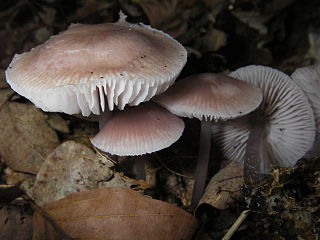
Mycena pura, commonly known as the lilac mycena, lilac bonnet, is a species of mushroom in the family Mycenaceae. First called Agaricus prunus in 1794 by Christian Hendrik Persoon, it was assigned its current name in 1871 by German Paul Kummer. Mycena pura is known to bioaccumulate the element boron.

Agrocybe pediades, commonly known as the common fieldcap or common agrocybe, is a typically lawn and other types of grassland mushroom, but can also grow on mulch containing horse manure. It was first described as Agaricus pediades by Swedish mycologist Elias Magnus Fries in 1821, and moved to its current genus Agrocybe by Victor Fayod in 1889. A synonym for this mushroom is Agrocybe semiorbicularis, though some guides list these separately. Technically it is edible, but it could be confused with poisonous species, including one of the genus Hebeloma.

Crepidotus mollis, commonly known as the peeling oysterling, soft slipper, jelly crep, or flabby crepidotus, is a species of mushroom. It's edibility is unknown, but it is probably inedible and possibly poisonous.

Cortinarius armillatus, commonly known as the red-banded cortinarius or bracelet cortinarius, is a late summer and autumn fungus usually found in moist coniferous forests, especially spruced ones. The species grows rarely in North America, but is common in Europe.

Montagnea arenaria, commonly known as the gasteroid coprinus, is a species of secotioid fungus in the family Agaricaceae. Originally named Agaricus arenarius by Augustin Pyramus de Candolle in 1815, it was transferred to the genus Montagnea by Sanford Myron Zeller in 1943. The species is characterized by a cap that has an apical disc, radial gills, a hymenophore, and spores with a prominent germ pore. It is inedible.

Bolbitius titubans, also known as Bolbitius vitellinus, and commonly known as the sunny side up is a widespread species of mushroom found in America and Europe. It grows chiefly on dung or heavily fertilized soil, and sometimes on grass. It is nonpoisonous.

Lycoperdon marginatum, commonly known as the peeling puffball, is a type of puffball mushroom in the genus Lycoperdon. A common species, it is found in Europe and North America, where it grows on the ground. It is characterized by the way that the spiny outer layer peels off in sheets.
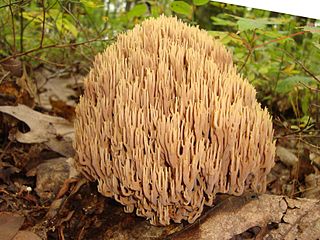
Ramaria stricta, commonly known as the strict-branch coral or strict coral mushroom, is a coral fungus of the genus Ramaria. It has a cosmopolitan distribution, and grows on dead wood, stumps, trunks, and branches of both deciduous and coniferous trees. Its fruit body is up to 10 cm tall, made of multiple slender, compact, and vertical parallel branches. Its color is typically light tan to vinaceous-brown. All parts of the mushroom will bruise when handled. There are several lookalike corals that can usually be distinguished from R. stricta by differences in coloration, bruising reaction, or microscopic features. The fungus is inedible due to its unpleasant odor and bitter taste.

Sarcomyxa serotina is a species of fungus in the family Sarcomyxaceae. Its recommended English name in the UK is olive oysterling. In North America it is known as late fall oyster or late oyster mushroom. Fruit bodies grow as greenish, overlapping fan- or oyster-shaped caps on the wood of both coniferous and deciduous trees. The gills on the underside are closely spaced, bright orange yellow, and have an adnate attachment to the stipe. It produces a yellow spore print; spores are smooth, amyloid, and measure 4–6 by 1–2 µm.
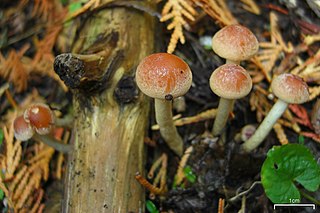
Pyrrhulomyces astragalinus, commonly known as the pinkish-orange pholiota, is a species of fungus in the family Strophariaceae. It was first described scientifically in 1821 by Elias Magnus Fries as a species of Agaricus. Rolf Singer transferred it to the genus Pholiota in 1951 and the species was transferred to its present genus in 2020 by E.J. Tian & Matheny. The fruitbodies of the fungus have pinkish-orange caps measuring 2–5.5 cm in diameter. The flesh is orange, blackening in age, with a bitter taste. They produce a reddish-brown spore print, causing it to be placed in its genus rather than Hypholoma, which it resembles. The spores are oval to elliptical, smooth with thin walls, and measure 5–7 by 4–4.5 µm. In North America, the fungus is found in the United States and Canada. In Europe, it has been recorded from France, Sweden, and Switzerland. Its mushrooms usually grow singly or in small clusters, sometimes on conifer logs.

Hygrocybe flavescens, commonly known as the golden waxy cap, is a species of Hygrocybe described from Michigan. It is considered nonpoisonous to humans. The species can be found in various forests and woodlands.

